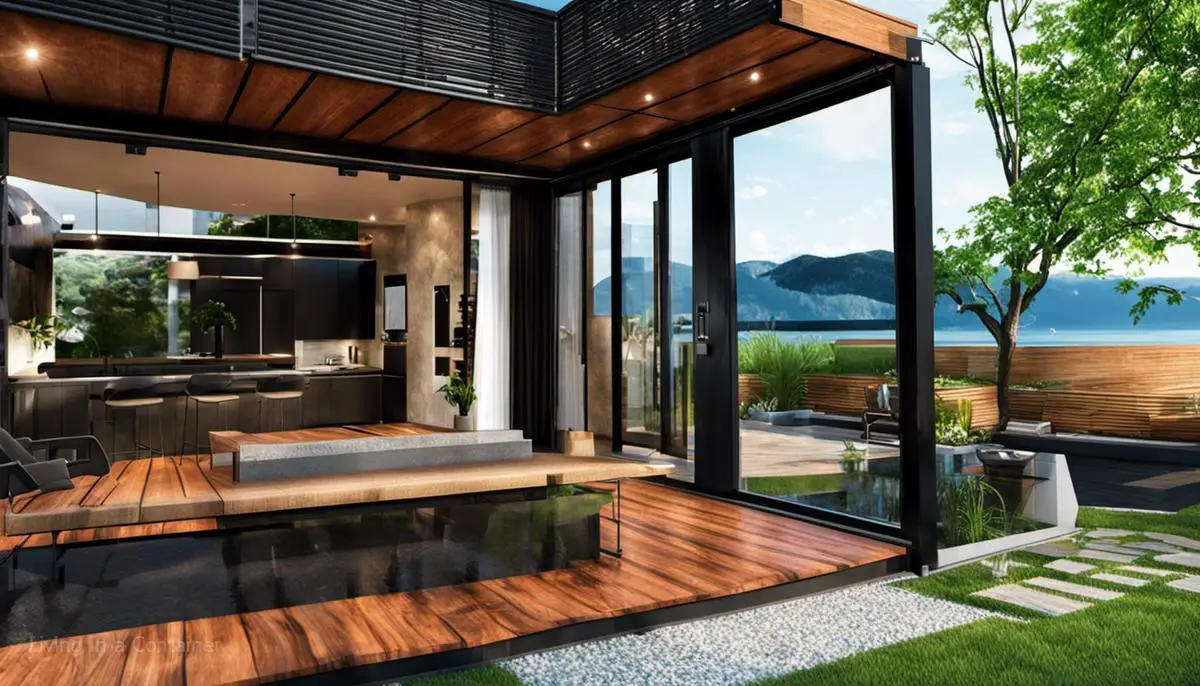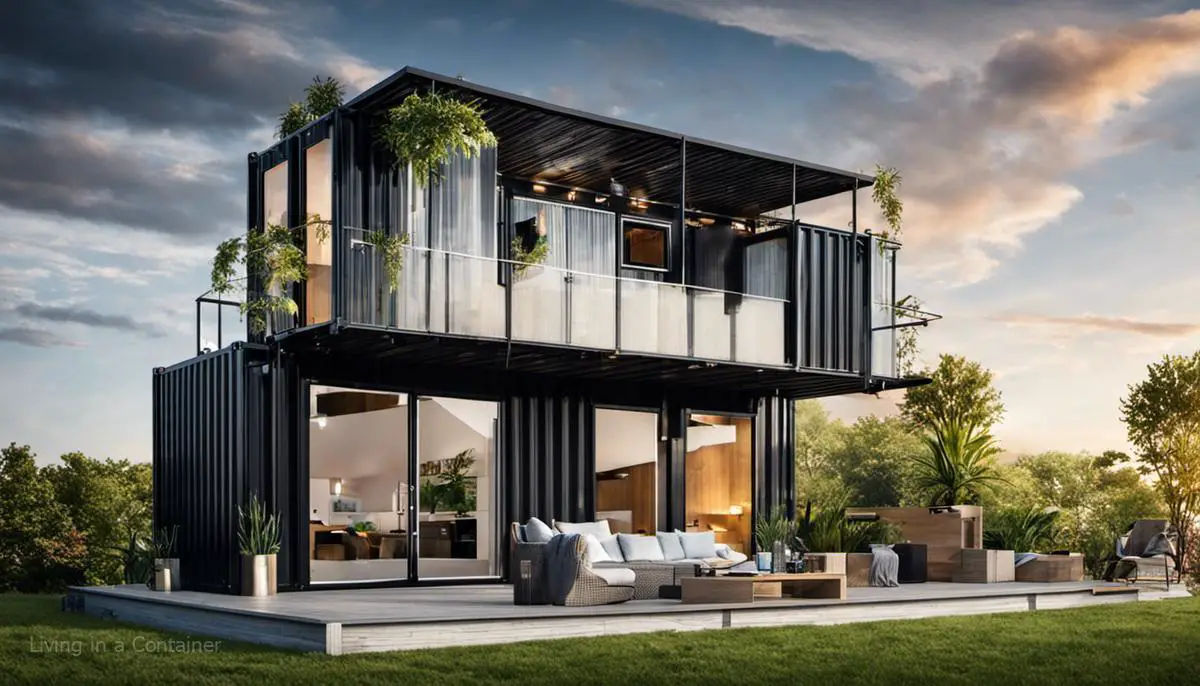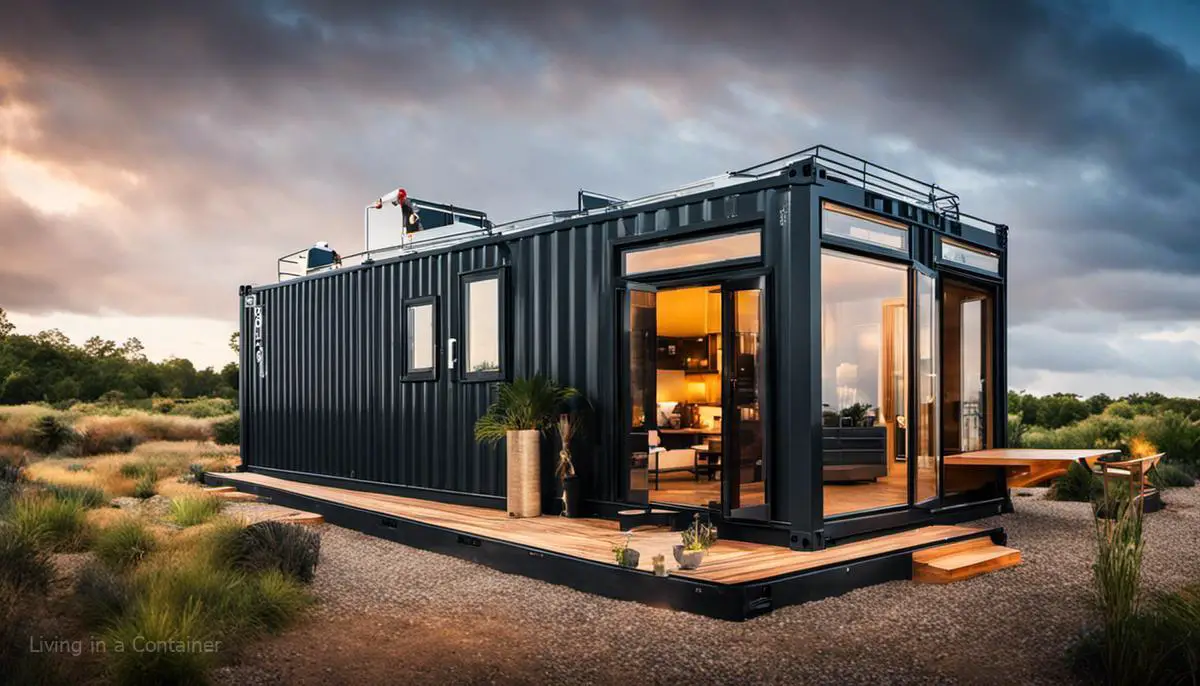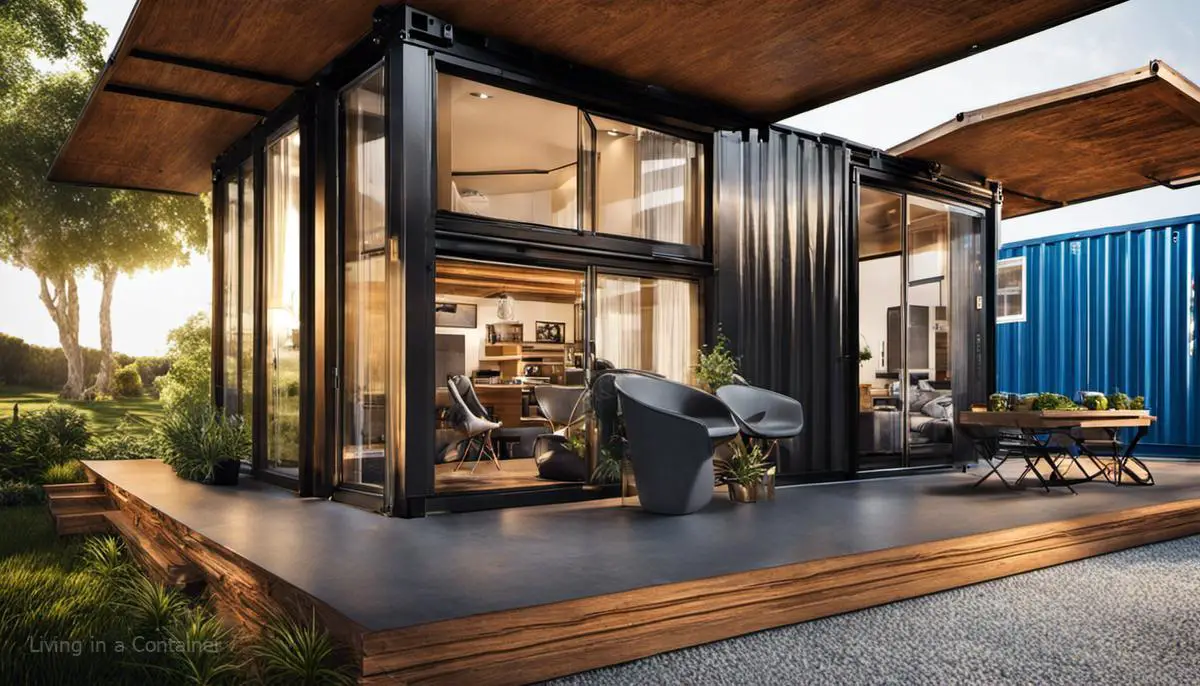In the ever-evolving realm of real estate, an innovative housing concept is making waves – homes built from shipping containers. A juxtaposition of creativity, cost-effectiveness, and sustainability, these homes are redefining conventional home construction methods.
This transformational trend beautifully coalesces the dynamics of construction economy, design flexibility, and a distinct appeal to the eco-conscious modern buyer who’s eager to leave a smaller carbon footprint.
The following discourse takes a deep dive into this unusual fusion of real estate and recycling; from its environmental impact to its market appeal, the nitty-gritty of regulatory challenges, and its future prospects let’s unravel the fascinating universe of shipping container homes.
Understanding The Concept
Cracking the Real Estate Market: A Look at the Innovation and Lucrativeness of Shipping Container Homes
In this rapidly evolving business ecosystem, it’s vital to identify and seize innovative opportunities that fill unmet market needs.
One such wave is cresting in the real estate sector – the advent of shipping container homes.
This clever concept, founded on the principles of sustainability, affordability, and modern design, is not only taking the property market by storm but is also paving the way for significant returns on investment.
The appeal of shipping container homes is rooted in their innovative design and cost-effectiveness.
These structures, crafted from robust steel boxes originally used for sea freight, bring minimalist, industrial design aesthetics to the residential space. With striking visual appeal and efficient use of space, these homes cater to a customer base enthralled by modern, eco-friendly living without breaking their budget.
We live in an era when the traditional norms of housing are being vigorously challenged. The younger generation is increasingly leaning towards flexibility, ease of transport, and eco-services. Shipping container homes fit this bill perfectly. Their inherent portability ensures homeowners can relocate their living space as needed, effectively eliminating the geographical limitations associated with traditional houses.
Shifting focus from the consumer side to the business perspective, the low entry and construction costs attached to shipping container homes offer an attractive return on investment.
With the cost of a used shipping container ranging from $2,000 to $5,000, and relatively low refurbishment expenses, developers see substantial margins when selling these homes at market prices.
Moreover, this innovative real estate concept can be a solution to housing shortages, particularly in urban areas with limited space. Building vertically instead of horizontally, shipping container homes can significantly increase housing density, serving both social and financial purposes.
Driving the momentum of this trend are several factors in the business and financial landscape. The escalating prices of traditional real estate and the soaring demand for low-cost housing are aligning perfectly with the affordable alternative offered by shipping container homes.
Additionally, the shift towards sustainability is pushing various sectors, including real estate, to innovate eco-friendly, energy-efficient solutions.
Furthermore, there is the potential for a broad professional network across several industries. This venture doesn’t just involve real estate developers and investors.
It spreads its wings to architects, interior designers, contractors, and suppliers, thereby creating a vast market ecosystem that promotes sustainable economic growth.
Taking all these factors into account, shipping container homes appear to be a well-refined business model.
The combination of low construction costs, a steadily growing customer base, strong network potential, and the contemporary drive for sustainability lends this innovative concept both an attractive buzz for consumers and a strong commercial lure for entrepreneurs.
So, it’s time to look beyond the conventional, venture into unexplored avenues, and embrace the change shipping container homes bring to the real estate industry. This disruptive innovation has the potential to revolutionize the housing market and provide significant dividends to those who act decisively and swiftly.
It has always been true in business, as in life – the future belongs to those who can imagine it, design it, and execute it while the ‘it’ is still in the mind of the innovator. It’s not just about spotting the trend but acting upon it. So, are you ready to catch this wave in the innovative real estate market?

Environmental Impact and Sustainability
On Sustainability: Shipping Container Homes and Environmental Conservation
As we delve deeper into the increasingly robust market of shipping container homes, it is impossible to ignore the striking potential that these innovative structures have to contribute to sustainability solutions and environmental conservation.
The green movement is swiftly reshaping business landscapes across all industries, and the housing market is no exception. Embracing this wave of transformation, the shipping container home industry stands out as a leader.
Pioneering the way, unpacking the concept of recycling and repurposing on an industrial scale while mitigating the impacts of overpopulation and urbanization on our environment.
One of the primary ways that shipping container homes contribute to sustainability is through their reliance on upcycling—converting excess, idle shipping containers into homes minimizes waste and the adverse effects associated with it.
While traditional housing models largely continue to depend on manufacturing new materials, often depleting natural resources in the process and creating waste, shipping container homes flip this model on its head.
The benefits go further than just the materials used. The design methodology imbibed by this industry is mainly modular, reducing the need for high-energy-consuming construction procedures, resulting in lower gas emissions.
Moreover, these homes often employ energy-efficient designs and climate-conscious features. Solar panels, insulation using recycled materials, and rainwater harvesting systems are common fixtures in these homes, further reducing the dweller’s carbon footprint.
Another critical point of significance is the disruption of urban sprawl. As metropolitan areas continue to expand outward, the environmental impact from the increased need for transportation and infrastructure development becomes more significant.
However, thanks to their compact design, shipping container homes encourage greater urban density, reducing the pressures of urban sprawl and resultant carbon emissions.
From an industry perspective, shipping container homes provide a unique opportunity, allowing companies to tap into a rapidly expanding, environmentally conscious demographic that values sustainability as much as stylish living.
By proving that these two elements are not mutually exclusive, businesses involved in shipping container home construction are influencing the broader housing market, driving trends towards greener alternatives.
To sum, the shipping container home industry is a proactive player in environmental conservation and sustainability, representing a dedicated response to our pressing environmental challenges, while delivering alluring, affordable housing solutions.
However, the future growth and impact of this industry depend on the willingness of entrepreneurs, industry leaders, as well as homebuyers, to recognize its merit and move away from conventional housing models.
Indeed, much like a wave of transformation, the sustainable potential of shipping container homes is ready to surge, as long as we’re ready to ride it.
Market Appeal and Profitability
Diving deeper into the shipping container homes market, one can’t fail to note the multifaceted profitability that is laden in this innovative industry.
Beyond the significant cost-saving implications, the eco-conscious shift, and the resolution of housing deficits, lies a vast reservoir of scalable, high-yield business opportunities.
This article probes the robust financial prospects that savvy entrepreneurs can leverage in the shipping container homes market.
A key marker to estimate potential profitability is revenue generation. Although figures may vary based on factors such as location, size, and finish level, a single shipping container home can bring in around $35,000 to $200,000.
This impressive range presents a fruitful business potential, especially when factoring in the comparatively lower construction expenses and shorter build times.
Real estate investors can rake in profits by offering a viable solution to high cost of living. The grim reality of ballooning real estate prices is creating a vacuum in affordable housing – a gap readily filled by shipping container homes.
Consequently, investors can increase their ROI by delivering these cost-efficient options to a wide range of audiences including first-time homeowners and retirees looking to downsize.
Moreover, shipping container home businesses can diversify their offerings to enter niche markets. These opportunities range from modular offices, pop-up retail shops, emergency shelters, to portable clinics, expanding the scope of potential clients. By tapping into these niche segments, businesses can multiply their avenues for revenue and reframe their growth strategy.
Another aspect worth considering is the visibility and brand loyalty offered by the shipping container homes industry.
Sustainable building practices and the drive for minimalistic living appeals to the progressively-minded populace, thereby enhancing brand reputation and customer retention.
From a strategic standpoint, the shipping container home industry could act as a magnet for attracting ‘green’ consumers and generating repeated business.
Lastly, the innovative architecture involved in shipping container home construction opens doors for partnerships with tech companies. Integrating smart home technology and renewable energy solutions into these homes becomes a unique selling proposition, driving demand and subsequently, profitability.
In conclusion, the shipping container homes market harbors an array of business opportunities with significant profitability.
Entrepreneurs, real estate investors, construction and tech companies are poised to capitalize on potential profits by delivering economical, sustainable and functional living solutions catered to the needs of today’s discerning consumers.
Visionaries who recognize the potential of this burgeoning industry are well-positioned to pioneer into this avant-garde realm of real estate.
By immersing in this forward-thinking community, they are not just investing in a business, but altering the landscape of housing and building a sustainable future, one container at a time.
Regulatory Challenges and Solutions
While shipping container homes present endless opportunities for a radical overhaul of the housing market, they are not devoid of significant challenges. The road to transforming an economy freight container into a broad, livable space is fraught with intricate regulatory constraints.
At the crux of these hurdles lie complex zoning laws. Many urban and suburban areas have strict zoning laws that place limitations on the style, size, and location of new residential buildings.
Shipping containers often get sidelined in this landscape due to their unconventional structure and inability to conform to traditional housing standards. Thus, navigating these zoning laws requires strategic planning and architecture acumen.
Building codes are another critical regulatory challenge. Safety standards established by the International Residential Code (IRC) and local building bodies should be adhered to during the construction.
Remember, the origin of these shipping containers was not for human habitation; hence, they need to be modified to meet habitable standards such as insulation, fire resistance, and ventilation.
Furthermore, acquiring building permits can be a significant roadblock. Sometimes bureaucratic red tape, along with a lack of understanding or familiarity with container homes within the bureaucratic machine, may delay or even deny the building permits.
But despite these daunting challenges, solutions abound. Incorporating innovative approaches and collaborating with the right stakeholders can help overcome these regulatory hurdles.
- Firstly, a comprehensive understanding of local zoning laws and building codes is essential. Engaging code experts or even partnering with law firms familiar with building regulations can expedite the approval process and mitigate roadblocks. It’s all about turning the unfamiliar into a well-known story.
- Secondly, fostering dialogue and education with local authorities about the benefits of shipping container homes can transform the way building permits are acquired. By illustrating their efficiency, cost-effectiveness, and environment-friendliness, stakeholders may foster a favorable perspective towards this housing model.
Strategic partnerships can also be a game-changer in this landscape. Teaming up with architectural firms and engineers with evidence-based expertise in this emerging housing sector can ensure that the design meets all safety and building standards.
Sourcing containers that meet the “one-trip” condition may also be a solution. These are essentially containers that have been used only once for transport, significantly increasing the chances of approval, as they are practically devoid of dents, structural issues, or toxic elements.
Last, but not least, the technology landscape is a potent ally. Smart technologies can turn these unconventional spaces into intelligent, sustainable, well-insulated homes.
Firms should consider joining hands with tech giants to build tech-led container homes, ensuring comfort while adhering to regulatory standards.
Though the journey of materializing shipping container homes is laced with challenges, they are far from insurmountable.
It calls for a strategic, innovative, and collaborative approach, turning this groundbreaking idea into a tangible reality. The journey of a thousand miles starts with a single step, a step worth taking.

Future Prospects and Expansion
As wise business pioneers, we always seize the opportunity to fill gaps in the market, and shipping container homes present just the golden opportunity the housing market needs.
Often, new ventures require technical know-how beyond our sphere of expertise. One must be willing to employ a comprehensive, strategic approach, including partnerships and collaborations.
Shipping containers, being tough built for sea travel, are synonymous with security, durability, and resilience to weather disturbances.
Unfortunately, this durability is a double-edged sword in the housing market where safety laws and building codes present some potential hurdles.
The complexity of zoning laws varies per locality, with some more welcoming to the concept of non-traditional housing than others. This necessitates an in-depth understanding of local regulations, acquiring the necessary building permits, and a keen focus on navigating the unique challenges inherent in this market.
However, these challenges are not insurmountable. One practical approach is to partner with architectural firms and engineers experienced in the niche of container homes.
These professionals would ensure compliance with safety standards and help alleviate the concerns of local authorities who may be skeptical about the safety and feasibility of container homes.
Another essential step is sourcing containers that meet the necessary safety standards.
This requires establishing relationships with manufacturers or suppliers who understand the necessities of the housing market. These relationships can be nurtured to form strategic alliances, creating a solid foundation for sourcing containers suitable for habitation.
Incorporating technology advances into container homes is more than just a buzzword; it’s a strategy.
Just as we see innovation breathing life into traditional industry sectors, so should we approach this new trend.
Container homes can benefit enormously from smart home technology, creating a stylistic blend of industrial durability and modern convenience.
Renewable energy solutions further cement this industry’s sustainable and environmental credentials. The feasibility of solar energy, smart meters, and other energy-efficient features both enhances the residents’ experience and delivers on the promise of a sustainable future.
Innovation, strategic partnerships, and an unflinching focus on the bottom line are keys to navigating complexities in business. It’s no different with shipping container homes.
The opportunity is ripe for the taking, with ample scope for growth, profitability, and brand enhancement.
Now, more than ever, forward-thinking entrepreneurs are needed to usher in this revolution in the housing market.
Seizing this opportunity requires strategic acumen, innovative spirit, and a collaborative approach – hallmarks of a successful business venture.
As we immerse ourselves in the countless possibilities of the future, one thing is crystal clear – shipping container homes are more than a transient trend; they represent a revolution in the housing industry.
Encouraging sustainable living, yielding solid profit margins, and offering intriguing design vistas, these homes cater to the pragmatic yet environmentally mindful homeowners of the new world.
While regulatory challenges may present some hurdles, they are far from insurmountable, as numerous successful ventures have proven.
With the right blend of burgeoning technology, adherence to legal requirements and sustained market interest, the scenario is ripe for the expansion and longevity of this promising industry.
In essence, the landscape of shipping container homes is only just unfurling its vast potential.

Awesome Blogg, helps me a lot!